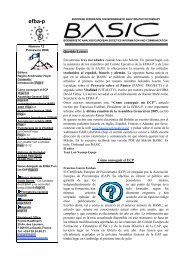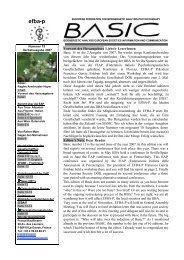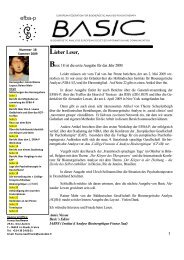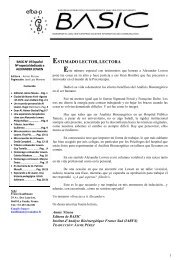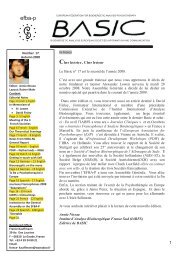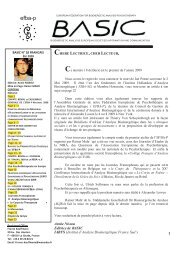December 2004 - European Federation for Bioenergetic Analysis ...
December 2004 - European Federation for Bioenergetic Analysis ...
December 2004 - European Federation for Bioenergetic Analysis ...
Create successful ePaper yourself
Turn your PDF publications into a flip-book with our unique Google optimized e-Paper software.
<strong>Bioenergetic</strong> <strong>Analysis</strong> does not deal with changing a person's character structure,<br />
however, it fosters a greater flexibility in thinking, behaviour, emotional and bodily<br />
expression so that the client can freely pursue his aims and achieve them more easily than this<br />
would have been possible, had he not worked upon his own structure. As a person's thinking,<br />
behaviour, feeling and body are likewise marked by life experiences or influenced by his<br />
character structure, therapeutic interventions can focus on any of these spheres. You can work<br />
with the body expression and observe the effect on feeling, thinking and behaviour or vice<br />
versa. (Lowen 1980, 1981)<br />
No matter which level is being worked upon, bioenergetic therapy is always about<br />
guiding a person towards a better understanding of the structure of his own thinking,<br />
behaviour, feeling and body. Only then it will be possible to examine if traditional and<br />
obstructive patterns originally meant to protect the person and help him to cope with life, can<br />
be changed in the future. The therapeutic goal is the increasing autonomy of the client or - in<br />
other words - to optimise the self-regulating system. (Mahr 2001 A)<br />
From a point of view focussing on the body the therapeutic process is described in this<br />
way: traumatic experiences are reflected in specific patterns of tension, especially in the<br />
muscles, bringing about “blockades” which are to control unwanted impulses, movements and<br />
emotions. Therapeutic work - often interventions on the body level - releases those tensions,<br />
which allows a new kind of self-awareness and perception of the body and sets free “frozen”<br />
feelings, which can then be worked upon by other therapeutic methods (Lowen 1980, 1981,<br />
Koemeda-Lutz 2002 D). Since the tension of a muscle is always determined by the amount of<br />
energy in the muscular cell and by corresponding neuronal impulses, any modification of the<br />
muscular tension directly attains neuronal structures. On the other hand the release of tension<br />
is only possible with the neuronal structure permitting. (Mahr 2001 A)<br />
The disorders treated in psychotherapy become disorders only when they are<br />
dysfunctional in a person's present living conditions so that the person's needs cannot be<br />
adequately met.<br />
Originally they were meant to solve a particular problem: they offered protection,<br />
guaranteed life or helped to bear it. Such attitudes and behavioural patterns can only be given<br />
up in view of clear alternatives. Consequently these processes take a certain time until new<br />
experiences can be made and a feeling of security can be established. <strong>Bioenergetic</strong> <strong>Analysis</strong><br />
fosters this development by stabilising the client's personality so that he can become aware of<br />
the multitude of his own resources. Bodywork is very efficient at promoting this kind of<br />
“grounding”. The client experiences being sufficiently strong, alive and lovably which<br />
15



